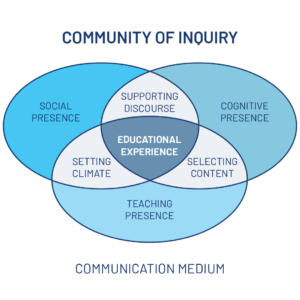‘Social learning’ has become a buzzword among eLearning professionals, and it continues to gain traction in the wake of Covid-19, where digital learning solutions are becoming even more prolific. This is hardly surprising – for years, eLearning experts have advocated for the inclusion of social learning tools and technologies in online education.
However, decisions surrounding the inclusion of social learning tend to be binary in nature – either on/off, enabled/disabled or collaborative/non-collaborative. Furthermore, social learning tools and technologies (such as chats, forums or wikis) are often considered adjunctively, as an add-on or afterthought to the overarching learning design. But ‘social learning’ is a broad and multifaceted term, and has many applications. So, what exactly is it that eLearning experts are referring to when brandishing the ‘social learning’ banner?
Defining Social Learning
UNESCO’s International Bureau of Education (n.d.) defines learning as ‘a process that brings together personal and environmental experiences and influences for acquiring, enriching or modifying one’s knowledge, skills, values, attitudes, behaviour and world views’. According to this definition, the personal and environmental experiences and influences are fused, resulting in a learning process that is inherently social. But what does it mean to be ‘social’?
The term ‘social’ is derived from the Latin word socii (meaning ‘allies’). However, the definition has expanded considerably to include (Merriam-Webster, n.d.):
- interactions between individuals and groups;
- ‘the formation of cooperative and interdependent relationships with others’; and
- relationships or interactions that are marked by companionship.
Based on these definitions, the meaning of ‘social’ can be summarised as the relation of human beings to one another, within a group or a community. As such, the term ‘social learning’ can be used to refer to the process whereby changes occur in one’s knowledge, skills, values, attitudes, behaviours and/or world views, specifically as a result of one’s relation to, or interaction with, other human beings.
Social Learning and Learning Theories
To understand why social learning continues to gain widespread support from experts in online education, we need to underscore just how inherent this ‘social’ factor is to the way in which human beings receive and process information. To do so, let’s briefly unpack the key theories that have been presented to explain how learning takes place, focusing on the roles of both the learner and the educator.

(Source: EDGE Education (Pty) Ltd, 2021; adapted from Meyer, n.d.; and Okolowitz, n.d.)
Behaviourism
Behavourism posits that behaviour is evoked by external stimuli. Behaviourists reject the idea that behaviour can be explained by uncovering internal mental states (i.e. processes that occur in the mind) (Tennant, 2018: 169). Instead, the learner is regarded as a blank slate from which desired behaviours are elicited through the use of specific prompts, as well as repetition and reinforcement. Although behaviourism doesn’t view learning as a necessarily social process, it does view learning behaviours as being determined by external stimuli in the environment. In a traditional learning context, where the educator uses prompts to elicit expected outputs from learners, these prompts are, essentially, social in nature.
Cognitivism
According to the cognitivist paradigm, humans are active participants in the construction of knowledge. Cognitivists assert that learners process information from the environment by creating and reshaping mental constructs, or schemata (Marquis, 2008). Here, the mental processes of storing and retrieving information, rather than just behavioural responses, are a key area of focus. The role of the educator is to engage these processes. Yet, these mental processes still occur in response to environmental stimuli (such as engagements with peers and educators), meaning that they, too, are socially mediated.
Constructivism
Like cognitivism, constructivist theories hold that humans are active participants in the knowledge construction process. Rather than simply processing information from the environment, learners subjectively assign meaning to the environment, and integrate the resulting new knowledge with what they already know. In this way, reality is constructed through interactions with the social world (Wenger, 2018: 227). This process occurs as a result of continuous reflection (a private activity) and collaboration (a social activity).
Connectivism
In seeking to understand learning in the digital age, connectivists maintain that humans acquire knowledge continuously, through connecting different sources of information. While some of these sources may be technological (such as networks and databases), one of the core principles of connectivism is that learning necessitates a diversity of opinions (Siemens, 2005). As such, the role of the educator is to connect curious learners with inquiring minds to networks – of peers and of knowledge. Again, this is certainly a social process.
While we could continue to explore the link between social learning and learning theories, we can see that the most prominent theories are in agreement:
Learning doesn’t occur in a vacuum, and it is significantly augmented by social factors.
Community and Inquiry-Based Learning
Now that we’ve examined the key learning theories and established that learning doesn’t occur in a vacuum, let’s shift our focus to the Community of Inquiry (COI) – a powerful framework for understanding the merit of social eLearning experiences in higher education. To better understand the roots of the COI framework, let’s begin by defining both community- and inquiry-based learning.
Community-based learning is a pedagogical approach that emphasises meaningful community engagement and reflection (Marshall University, n.d.). Inquiry-based learning is described by Garrison and Vaughan (in Australian Catholic University, n.d.) as a multidisciplinary, problem-driven approach in which a small group employs research methods, such as information gathering and synthesis of ideas, and engages in critical discourse. Both community- and inquiry-based learning are underpinned by collaborative constructivism (ColCon), which holds that knowledge/meaning is constructed by ‘fusing individual construction of meaning and collaborative validation of understanding’ (Garrison, 2009: 355).
The COI framework is an excellent evidence-based example of an online community- and inquiry-based approach to teaching and learning. Specifically, it serves as a ‘coherent structure of a transactional educational experience whose core function is to manage and monitor the dynamic for thinking and learning collaboratively’ (Garrison, 2017: 24). It focuses on the intentional development of an online learning community (i.e. a community of inquiry), with an emphasis on creating deep and meaningful learning experiences through the development of three interdependent elements, or ‘presences’ – i.e. social presence, cognitive presence and teaching presence (Garrison et al., 2000: 88).

(Source: EDGE Education (Pty) Ltd, 2021; adapted from Garrison et al., 2000: 88)
Social presence
Social presence refers to the ability of participants in a community of inquiry ‘to identify with the group, communicate openly in a trusting environment, and develop personal and affective relationships progressively by way of projecting their individual personalities’ (Garrison, 2017: 25). They thereby present themselves as ‘real people’. In its most simple form, social presence can be thought of as engagement with participants. This corresponds with Moore’s (1989) learner-learner interaction – one of three levels of interaction present in distance education.
Cognitive presence
Cognitive presence refers to ‘the extent to which learners are able to construct and confirm meaning through sustained reflection and discourse in a critical community of inquiry’ (Garrison et al., 2001: 11). Cognitive presence is developed through engagement with content, and corresponds with Moore’s (1989) learner-content interaction. At its core is the process of inquiry.
Teaching presence
If cognitive and social processes are to result in a productive and sustainable transactional educational experience, they must be designed, facilitated and directed (Anderson et al., 2001). This is the role of teaching presence – to bring together the elements of a community of inquiry in a balanced and functional relationship. In other words, it serves to ‘manage the transactional balance, and by engaging learners, collaboratively guide the process of achieving worthwhile and intended learning outcomes in a timely manner’ (Garrison, 2017: 69). In this way, teaching presence can be thought of as engagement with regard to the goals and direction of learning, corresponding with Moore’s (1989) learner-instructor interaction.
As its name suggests, the COI framework relies on both community and inquiry – both of which are essential to higher education. The social nature of education, and the role that interaction, collaboration and discourse play in the construction of knowledge, underscore the importance of community. In addition, inquiry is reflected through cognitive presence (Garrison and Vaughan, 2007: 9). The COI approach is therefore social by its very nature – and social learning is not adjunctive, but rather, central to the design of the educational experience.
Delivering a Community-Based Educational Experience
So, how do we go about delivering an online community-based educational experience?
The answer lies in making community – with its social interaction, collaboration and discourse – central to the learning design of academic courseware. In the eLearning space, content is no longer king. In fact, the overabundance thereof has rendered it insufficient for deep and meaningful learning. While it may seem counterintuitive, Kao (2021) argues that this excess of content doesn’t necessarily translate into increased engagement, and may actually put students at a disadvantage.
Added to this, course content and teaching and learning are too often regarded as distinct components of the educational experience. Harden (2001), for example, describes ten windows through which to view a curriculum – one of them being learning resources. However, because technology is changing the relationships between these windows, course content can no longer be viewed as a separate curriculum window, and the baseline learning opportunity needs to be engagement with learning resources (Hibling, 2018). Thus, when integrated with socialisation, the development of social, cognitive and teaching presences is enabled, and content becomes a conduit for dialogue – thereby leading to reflection and, ultimately, deep and meaningful learning.
Designing the (social) future of learning
EDGE Education is designing the future of learning by using an inherently social approach to online education. The CourseBook™ is our expression of a 21st-century online learning experience that is both community- and inquiry-based: a fusion of the traditional print textbook format with the engaging digital and socialisation elements of the online course. While working through the multimedia-rich EDGE Digital CourseBook™, students also have access to the Community Space, or CommSpace™, with the touch of a button.
A unique aspect of the CommSpace™ is that students can send contextualised messages – anchored to selected excerpts of EDGE Digital CourseBook ™ content – to their community. Aligned with the COI model, these contextualised messages enable students to engage in sustained, purposeful discourse and reflection, and to collaboratively validate their understanding with other members of the community.
The CommSpace™ also allows for the creation of communities of inquiry at various levels. At its broadest level, the community can consist of all members of an institution. Using the group functionality, this community can then be subdivided into groups working on the same CourseBook™. From here, educators and students can create even smaller communities within the CourseBook™, to facilitate inquiry at different levels.
In this way, social learning (and, specifically, community- and inquiry-based learning) is inherent to the very design of the EDGE Digital CourseBook™.

Conclusion
While the educational landscape has undergone dramatic changes as a result of technology, computer-mediated communication has, in many ways, brought us closer to our roots. After all, collaborative learning isn’t a new concept. Humans, through their shared experiences, have traded knowledge in this way for centuries. We learn from our environment and from other humans who occupy it.
To maximise how we learn in the 21st century (and beyond), educational culture needs to shift from being individualistic, toward an inherently social approach. A step in the right direction involves making social learning tools a fundamental aspect of the learning design of online educational experiences. Once this has been achieved, online learning can become the mechanism that enables the Community of Inquiry framework to be deployed on a mass scale, thereby allowing this age-old means of knowledge transaction to take centre stage once again.
References
Anderson, T., Rourke, L., Garrison, D. R. and Archer, W. (2001), ‘Assessing Teaching Presence in a Computer Conferencing Context’. Journal of Asynchronous Learning Networks 5(2): 1–7.
Australian Catholic University [website] ‘The inquiry process’. <https://leocontent.acu.edu.au/file/ccbe60fc-4a3c-4a2c-a80e-286a4946a9f3/1/html/ote_3_30.html> accessed 6 October 2021.
EDGE Education. ‘“Collaborative learning isn’t a new concept. Humans, through their shared experiences, have traded knowledge in […]’. LinkedIn [website] September 2021. <https://www.linkedin.com/posts/edge-academic-edtech_edgeinsights-21stcenturylearning-digitaleducation-activity-6831174473614422016-rbMI> accessed 6 October 2021.
Garrison, D. R. (2009), ‘Communities of inquiry in online learning’. In Rogers, P., Berg, G., Boettcher, J., Howard, C., Justice, J. and Schenk, K. (Eds.) Encyclopedia of Distance Learning. 2nd edn. Hershey, PA: IGI Global, pp. 352−355.
Garrison, D. R. (2017), E-Learning in the 21st Century: A Community of Inquiry Framework for Research and Practice. 3rd edn. New York, NY: Routledge.
Garrison, D. R., Anderson, T. and Archer, W. (2000), ‘Critical Inquiry in a Text-Based Environment: Computer Conferencing in Higher Education’. The Internet and Higher Education 2(2–3): 87–105.
Garrison, D. R., Anderson, T. and Archer, W. (2001), ‘Critical Thinking, Cognitive Presence, and Computer Conferencing in Distance Education’. American Journal of Distance Education 15(1): 7–23.
Garrison, D. R. and Vaughan, N. D. (2007), Blended Learning in Higher Education: Framework, Principles, and Guidelines. San Francisco, CA: John Wiley & Sons.
Harden, R. M. (2001), ‘AMEE Guide No. 21: Curriculum mapping: A tool for transparent and authentic teaching and learning’. Medical Teacher 23(2): 123–137.
Hibling, A. (2018), ‘An Inclusive Business Model Innovation in the Delivery of Blended Undergraduate Medical Education’. Unpublished dissertation (MPhil), Cape Town, South Africa: Graduate School of Business. OpenUCT [website] <https://open.uct.ac.za/bitstream/handle/11427/30458/theses_com_2018_Hibling_A.pdf?sequence=4&isAllowed=y> accessed 3 November 2021.
International Bureau of Education [website] ‘Most influential theories of learning’. <http://www.ibe.unesco.org/en/geqaf/annexes/technical-notes/most-influential-theories-learning> accessed 4 October 2021.
Kao, W. (2021), ‘In Online Ed, Content Is No Longer King—Cohorts Are’. Future [website] <Marquis, J. (2008), ‘The End of Instructional Design’. In Kidd, T. T. and Song, H. (Eds.) Handbook of Research on Instructional Systems and Technology: Volume I. Hershey, PA: Information Science Reference, pp. 142–153.
Marshall University [website] ‘What is community-based learning?’ <https://www.marshall.edu/ctl/community-engagement/what-is-service-learning> accessed 4 October 2021.
Merriam-Webster [website] ‘Social’. <https://www.merriam-webster.com/dictionary/social> accessed 4 October 2021.
Meyer, C. ‘Comparing Learning Theories’. IDT Portfolio [website] <https://caitlinmeyer.github.io/idt-portfolio/100x/comparing-learning-theories> accessed 4 October 2021.
Moore, M. G. (1989), ‘Three types of interaction’. American Journal of Distance Education 3(2): 1–7.
Okolowitz, H. ‘Comparing learning theories’. Griffl.org [website] <https://griffl.org/comparing-learning-theories/> accessed 4 October 2021.
Siemens, G. (2005), ‘Connectivism: A Learning Theory for the Digital Age’. International Journal of Instructional Technology and Distance Learning 2(1): 3–10.
Tennant, M. (2018), ‘The life history of the self’. In Illeris, K. (Ed.) Contemporary Theories of Learning: Learning Theorists… In Their Own Words. 2nd edn. Abingdon: Routledge, pp. 166–178.
Wenger, E. (2018), ‘A social theory of learning’. In Illeris, K. (Ed.) Contemporary Theories of Learning: Learning Theorists… In Their Own Words. 2nd edn. Abingdon: Routledge, pp. 219–228.



